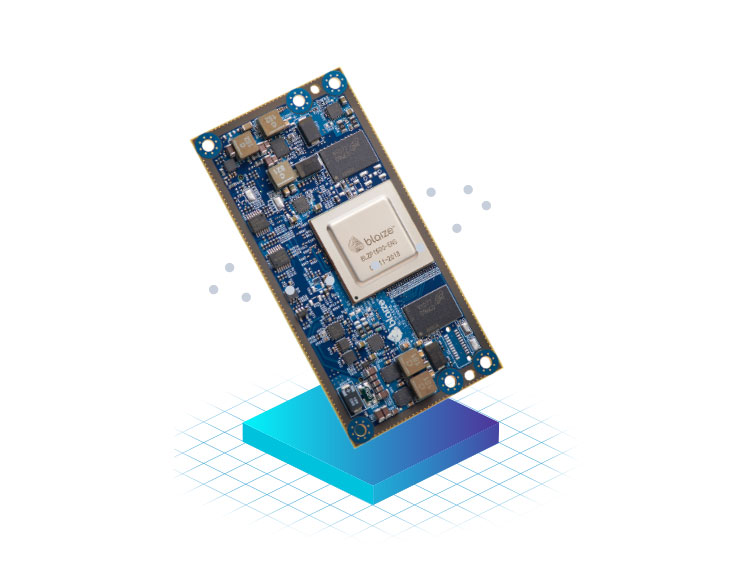The California-based startup is taking on chip industry incumbents with the backing of carmakers like Denso and Mercedes-Benz.

The automotive market is a tough one for younger semiconductor companies to enter — procurement cycles are long and incumbent chip manufacturers like Intel and Nvidia tend to dominate. But Blaize, a California-based startup developing edge computing processors, is one of the few that has a chance to take a slice of the market. The company’s semiconductors are designed to handle the heavy computing requirements of artificial intelligence without using excessive power — exactly the kind of thing that cars need to be able to do as they become increasingly automated.
“At our core we are an edge computing company,” says Dinakar Munagala, the chief executive and co-founder of Blaize. “We have a core processor design, software and everything that it takes to commercialise edge AI computing with our focus being in two markets, automotive and smart vision.”
Much of AI development currently happens in data centres, where large banks of servers can handle the compute load needed. But for AI to really reach its potential, the processing needs to be untethered from the data centre and able to be done anywhere, on small devices, even on a single chip.

Munagala says the potential of this kind of edge AI is a million times larger than what is happening in data centres. “It can be utilised in everything from mobility to healthcare,” he says.
“Making sure our roadmaps align with corporations, working closely with them and making sure the technology we are building is relevant to the end in a customer and partner relationship is critical and was a key learning point for us.”
Dinakar Munagala, chief executive and co-founder, Blaize
Blaize produces 16-core chips that can deliver 16 tera operations per second (TOPS) of AI inference horsepower within a 7-watt power envelope. This means Blaize’s chips can provide up to 60 times higher efficiency levels than graphic processing units (GPUs) and central processing units (CPUs) for edge computing applications.
In addition, its technology enables 50 times less memory bandwidth and 10 times lower latency, allowing for multithreading and streaming programming to occur.
“Our current product is based on a chip that is in the market, as well as accelerator cards and small modules. These are palm sized modules that can power small boxes which are on the backside of our organised systems, or it can go into servers,” says Munagala.
Blaize is going directly up against the market leaders. “Our product in the market is actually beating competition against the likes of Nvidia and domestic revenue,” says Munagala.
“For an end customer, they usually ask if the product can complete applications efficiently. This means you do need full programmability and when you look at the spectrum of AI and chip companies out there, there is really only Nvidia and us who have developed full programmability,” he says.
Founded in 2010, Blaize’s leadership team consists of nine industry experts who have worked for several IT and digital manufacturing companies such as Intel, Nvidia and Apple. Munagala is an IT and semiconductor sector veteran, having spent 11 years at the graphics division of Intel before founding Blaize.
The investment climate
Investment in in-car semiconductors has been increasing since the introduction of Tesla, with its highly software-based vehicles.
“It is clear that companies have started realising the potential of automotive semiconductors and software in vehicles, so they have begun investing. They need a truly open, fully programmable processor, and the market has hardly any of these which is why they have begun investing in those startups that produce this,” says Munagala.
Blaize has raised $136m in total funding, with its last funding round occurring in 2021 when Blaize raised $71m in a series D round led by the global investment firms Franklin Templeton and Temasek. Corporations such as Denso, the Japan-based automotive manufacturer have also provided the startup with significant financing.
“We have had support from the likes of Denso and Mercedes Benz who are both customers and have invested in the company. The relationship developed soon after we started collaborating with them which led to them wanting to provide financing into our product,” says Munagala.
But investment from corporations is not the only benefit Blaize has received, Munagala claims it has provided them with a huge learning curve.
“Especially in a market like ours that has long cycles, it’s good to have these co-development efforts,” he says, “This collaboration with corporations comes about in the form of product development and how they see our roadmap as well as making an investment in us.”
He continues, “So I think the key learning are how we work closely to align these roadmaps and the long cycles in the industry. It is important that we know that the technology that we are building has a home. It is not like we build something and then five years later we find out it does not meet the customers’ needs which can be dangerous for a startup.”
Blaize continues to use its funding to get the percentage of products to market and accelerate its roadmap to commercialisation. The company is still growing and actively seeking new partnerships to continue to boost its success.
“Making sure our roadmaps align with corporations, working closely with them and making sure the technology we are building is relevant to the end in a customer and partner relationship is critical and was a key learning point for us,” adds Munagala.








